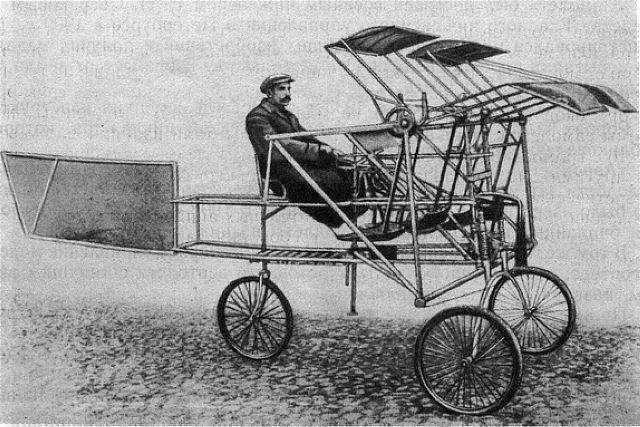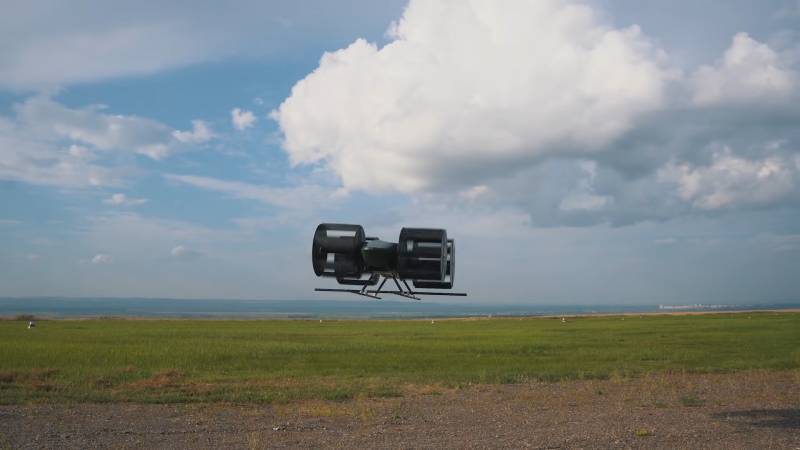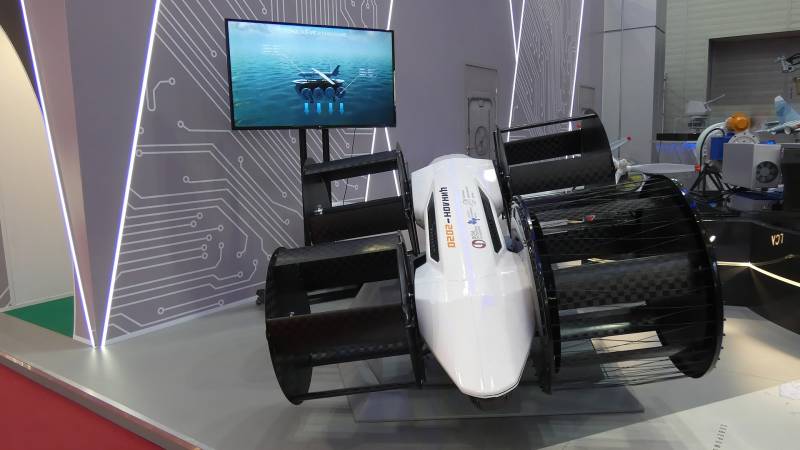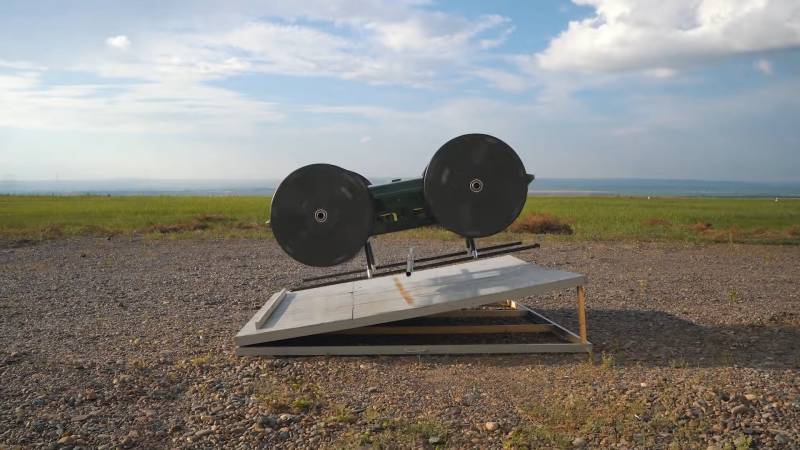In Russia, they returned to the idea of a cycloplane
In Russia, they returned to the idea of building a cycloplane or cyclocopter.
In recent years, the device has been repeatedly demonstrated at exhibitions. For the first time in the latest stories the cycloplane model was shown as part of the Army-2020 forum. At the same time, it was reported that a full-size flying model should be ready in 2024.
Then Grigory Makeich, the head of the Cyclone project from the FPI, told TASS reporters that an unmanned aerial vehicle weighing 60 kg was already undergoing flight tests. It was planned to install a hybrid power plant on the device, which would allow it to fly for more than an hour.
What is a cyclolet?
A cycloplane or cyclocopter is a design of an aircraft in which rotating rotors are used to create the necessary lifting force. Such devices resemble in appearance a hybrid of modern quadrocopters and paddle steamers from the works of Mark Twain. Such a design has all the same pros and cons as classic helicopters, primarily the ability to perform vertical takeoff and landing, as well as hover in the air.
Despite the fact that the scheme of the cycloplane was first presented and studied at the beginning of the XNUMXth century, it was only in the XNUMXst century that it came to the construction of flying models. At the same time, the very scheme of cycloplanes was quite simple and was born precisely by analogy with the operation of the paddle wheels of the first sea and river steamers.
The main structural element of any cyclocopter is a cycloid propeller, which looks like a paddle wheel. The pitch of the blade profiles (angle of attack) can be set both collectively and individually. In the latter version, the blades are individually corrected and adjusted by means of a control system installed on the aircraft.

In normal flight mode, the cycloplane develops lift and forward thrust. In this case, the scheme of the aircraft allows you to change the thrust in any direction in a plane perpendicular to the axis of the rotor. To rotate the device around its axis, a thrust differentiation between two rotors (one on each side of the aircraft fuselage) can be used.
Attempts to create a cycloplane were made in Russia at the very beginning of the XNUMXth century, but things did not move beyond prototypes. With certain exaggeration, such developments could include the aircraft of the military engineer Sverchkov (“Sverchkov’s Aircraft”). The development of Evgeny Pavlovich Sverchkov was also called the "wheeled orthopter".
Although according to the scheme, the device could be called a cyclocopter or a cyclogyro rather conditionally, there were some similarities in the project. To create lift and thrust on his plane, Sverchkov planned to use "paddle wheels" consisting of 12 blades and installed in three groups. The wheels were driven by a 10 hp engine. With. The interesting features of the device could be attributed to the three-wheeled landing gear, which was made resettable, it was used only for takeoff.
The frame of the aircraft was made of thin-walled steel pipes and bamboo, and the skin was made of light cotton fabric, which provided an empty apparatus with an engine with a weight of about 200 kg. The device, built with the money of the Main Engineering Directorate of St. Petersburg, never took off. Despite the fact that the development was demonstrated at the exhibition of the latest achievements in 1909 even before the tests were carried out and even received a medal, the failure of the tests led to accusations of embezzlement of public funds. Against this background, Sverchkov finally abandoned his project.
Later in the Russian Empire they returned to this idea several times. But the project of 1914 from Alexander Nikolaevich Lodygin was immediately refused by the government. Another inventor, A.K. Medvedev, was refused by the Military Industrial Committee in the same year. In 1916, the project of A. G. Mikhailov was recognized as promising for further scientific research, but it was not possible to bring it to life because of the war.
What is known about the development of FPI?
Back in 2017, the Foundation for Advanced Study held an open competition called "Free Rise". The aim of the competition was to find the best proposals for a vertical takeoff or ultrashort takeoff and landing transport aircraft. The goal was to find something new in relation to the already existing ones. aviation solutions for air mobility. Interest in such projects is shown by both civil and military spheres.
Siberian engineers and scientists took part in the competition announced by FPI. Thus, the Flash-M company and scientists from the Institute of Thermal Physics of the Siberian Branch of the Russian Academy of Sciences submitted the concept of a cycloplane to the competition. Subsequently, this application resulted in the creation of a technology demonstrator, which was first shown as part of the Army-2020 forum.
According to the official website of the FPI, today the Institute of Thermal Physics of the Siberian Branch of the Russian Academy of Sciences is working on the project to create a cycloplane in cooperation with the companies Flash-M, AWACS-Geoservice (both companies in Krasnoyarsk) and the Siberian Research Institute of Aviation named after S. A. Chaplygin.
At the end of January 2022, Dmitry Markovich, who holds the post of director of the Institute of Thermal Physics. S. S. Kutateladze of the Siberian Branch of the Russian Academy of Sciences, told reporters that the work on creating an aircraft demonstrator based on alternative principles has been completed. In an interview with Interfax, Markovich noted that scientists from Novosibirsk have begun work on creating a manned prototype of a cycloplane capable of vertical takeoff and landing, including on inclined surfaces.
According to Dmitry Markovich, scientists and engineers are currently on their way to creating a larger aircraft weighing approximately 2,5 tons, which would have a payload of 600 kg. This device could be used for a variety of purposes. Earlier, the possibility of creating a transport version of the apparatus weighing about 10 tons and with a carrying capacity of 4 tons was mentioned as the most distant prospect in the media.
According to Markovich, it would be a full-fledged flying car for solving special problems, which would be of interest to the Ministry of Emergency Situations, and in the long term, for example, city taxis. At the same time, Markovich noted that in order to introduce such equipment, it would be necessary to change Russian legislation, since modern legislation does not regulate or provide for the appearance of flying cars in Russian cities.
Answering a question about the development timeframe, the specialist named four years, noting that a full-size flying model could be ready as early as 2025. Among the advantages of the developed aircraft with cyclic propulsion, unmanned samples of which began to fly in late 2020 - early 2021, the director of the Institute of Thermal Physics of the Siberian Branch of the Russian Academy of Sciences called the low noise level. In dense urban areas, low noise levels can be a very pleasant bonus and advantage.
According to Markovich, about five or six states are working in the world today in the field of creating cycloplanes, while our country occupies a leading position at the level of creating such technology demonstrators. Earlier it was already reported that a flying model of a cycloplane weighing up to 60 kg was tested in Russia. This model has demonstrated good performance in flight duration, as well as maneuverability.
What are the advantages of a cycloplane?
A cycloplane, like any aircraft, has its advantages.
The main advantages of such aircraft include compact size, low noise level compared to quadrocopters and helicopters. In addition, cyclic thrusters allow the aircraft to change the direction of the thrust vector by 360 degrees. This feature significantly increases the maneuverability of the cycloplane.
According to the FPI representative, the cycloplane can be effectively used in hard-to-reach areas, including mountains, as well as in dense urban areas. The device is able to fly among obstacles, as well as moor to vertical surfaces and take off and land from inclined surfaces, which a helicopter and a quadrocopter cannot do. Also, the advantages of the device being developed in Russia include peripheral protection of propellers in the event of a collision with obstacles.
At the Army-2020 forum, Grigory Makeich, the head of the Cyclone project from the Advanced Research Foundation, said that the military is also showing interest in the new development of Russian scientists. In particular, the possibility of creating ground-based and deck-based cycloplanes that could be used for landing operations was mentioned. In military versions, the drone can be used both in strike and reconnaissance versions. At the same time, the low noise level will also become a very important advantage of the aircraft.




Information